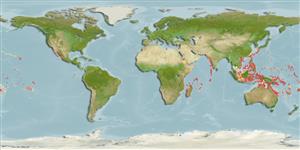Preferred temperature (Ref.
123201): 24.7 - 28.9, mean 27.7 °C (based on 518 cells).
Phylogenetic diversity index (Ref.
82804): PD
50 = 0.5000 [Uniqueness, from 0.5 = low to 2.0 = high].
Bayesian length-weight: a=0.00708 (0.00333 - 0.01504), b=3.09 (2.92 - 3.26), in cm total length, based on LWR estimates for this (Sub)family-body shape (Ref.
93245).
Trophic level (Ref.
69278): 3.2 ±0.3 se; based on size and trophs of closest relatives
Widerstandsfähigkeit (Ref.
120179): hoch, Verdopplung der Population dauert weniger als 15 Monate. (Preliminary K or Fecundity.).
Fishing Vulnerability (Ref.
59153): Low vulnerability (10 of 100).
Nutrients (Ref.
124155): Calcium = 243 [103, 522] mg/100g; Iron = 1.05 [0.50, 2.11] mg/100g; Protein = 17.8 [15.8, 19.5] %; Omega3 = 0.104 [0.042, 0.222] g/100g; Selenium = 25.4 [10.3, 64.5] μg/100g; VitaminA = 143 [36, 543] μg/100g; Zinc = 2.78 [1.71, 4.30] mg/100g (wet weight);
